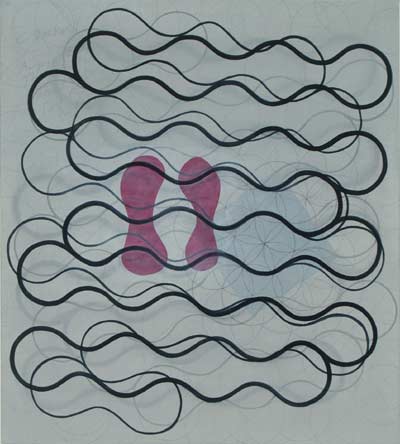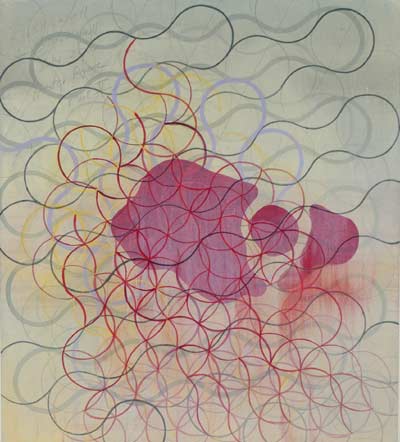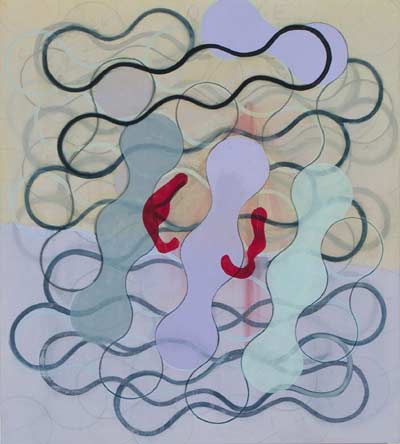Exposing Scarlet: A Visual Response to the Scarlet Letter
Red-letter days at the BCA reveal society’s secrets
By Cate McQuaid, October 10, 2004
Nathaniel Hawthorne laid open a powerful underground stream in “The Scarlet Letter” – one in which desire and shame converge. Writing in 1850 about the pride and passion of Hester Prynne, the Puritan woman condemned to wear a red “A” stitched to her dress after refusing to reveal the father of her unborn child, Hawthorne dissected the battle between the heart of the individual and the need of the community to keep individuality in check.
It was a defining work, not just of American literature but of American culture, a book with a central dilemma still relevant today as we choose to survive socially by hiding central truths about ourselves. What power do those hidden truths take on? What do they do to the holders of the secrets and to the people from whom the secrets are kept? Thirteen artists throw themselves into this bruised and juicy material in “Exposing Scarlet: A Visual Response to the Scarlet Letter” at the Mills Gallery at the Boston Center for the Arts, a slightly uneven but largely provocative, rewarding show.
Organizers Ed Burnam, Cynthia Atwood, and Lucinda Bliss invited artists to create work in response to “The Scarlet Letter.” Everything on view was made this summer, after the artists read the book, rather than pulled out of storage to fit a call for entries. The results pulse with life, recontextualizing a 154-year-old story into the 21st century.
As with Hester’s illegitimate daughter, Pearl, these days the labeling starts before birth. Pattie Belle Hastings’s “The Scarlet Genotype,” posits that now the label is not a moral judgment, it’s a biological one. A plaster cast of a full-term pregnant torso sits in a white rocker set in the corner of a white room. Bells tinkle eerily as molecular diagrams of Parkinson’s and sickle cell disease project over the breasts and belly; DNA is the equivalent of today’s scarlet letter.
Hester embroidered her badge of sin, making it into a work of art. Many artists here examine the power of that “A.” In Lynn Imperatore’s “Red Letter Day” series, women drawn in graphite in historical dress hold gold-framed red “A’s” over their hearts. “With no Apology” reads the work in one frame. “A is for my ambivalence, autonomy, anonymity, abortion,” says another, recalling one of the deepest secrets many women keep.
Cynthia Atwood’s 7-foot-tall “Corporeal A” transforms the letter into something writhing, both beautiful and beastly, with a life of its own; stitched from velvet and mink, the “A” sprouts tentacles. Lucinda Bliss pins the “A” in four drawings onto animals representing truth, hunger, vengeance, and love – the engines of “The Scarlet Letter,” each of which can evoke shame. In the book, the audacity of Hester’s elaborate “A” flies in the face of Puritan aesthetics. Lauren Fensterstock examines the double-edged sword of such display in “Traces.” A real, preserved large spider stands on a white surface; its shadow lies beneath, drawn in rubies – lovely or lethal? Or both?
Other artists take inspiration not from theme, but character. Ed Burnam and Craig Stockwell make four-part series. Stockwell paints a repeating pattern of undulating lines, which sometimes form joined circles. Using this minimal, almost mathematical base, he builds up different energies, some heated, some clogged, some urgent, as they fit the character (or characters) they describe.
Burnam’s “Four Portraits: Chillingworth, Dimmesdale, Prynne and Pearl” references Hester’s dangerous husband, her lover, herself, and their daughter. Each is represented by a totem of boxes, fabric, and torn pages from the Bible and “The Scarlet Letter.” Hester’s, the tallest, is topped with the word “Desire.” Chillingworth’s is crowned with “Savage,” Dimmesdale’s with “Guilty,” and Pearl’s, sadly, with “Alone.” It’s less effective than Stockwell’s series; distilling each character down to one word draws attention away from the other materials in the totems and simplifies the story.
Sabrina Fadial embodies Hawthorne’s characters – Hester with a coiled red rope, like an umbilical cord hanging from the ceiling, and Pearl in the plaster sculpture “Sweet Moral Blossom,” a huge flower with luscious opening petals; the pure white suggests innocence, but the form suggests welcoming feminine sexuality.
Text itself holds a lot of power for some artists. Todd Bartel’s delicate
“‘A’merican Sublime” sits framed in a corner, opening like a book. He mixes collaged passages from Hawthorne with fragmented visual references to painters such as Ralph Blakelock and Frederic Church (Hawthorne’s contemporaries), and 19th-century photography, describing the cultural landscape that fomented “The Scarlet Letter.” “Exposing Scarlet” falls short with artists who refuse to explore the conflicts of secret-keeping and instead defiantly shout the hidden stories from the rooftops. Virgo Paraiso and Tino Rodriguez spin the once verboten subject of gay love and marriage in their steamy, pristine little painting, “Utopia,” in which two beautiful men in a tropical Eden hold each other. It’s declarative rather than inquisitive, and disappointing.
You can see the tendency of the artist to thumb his or her nose at community in deliberately provocative pieces, which seem more intended to shock than to reflect – Colette Calascione’s “Anarchist in Love,” for instance. Like “Utopia,” the painting itself is masterfully fastidious; it recalls 16th-century royal portraiture – only here, the Queen Elizabeth figure is bare-breasted beneath her high, stiff collar.
It would be easy to think that Nancy Christensen’s painting triptych “Love Letter” falls into the same angry camp: The text darting across the two outside paintings are lifted from letters to Penthouse. They bracket text from a love letter F. Scott Fitzgerald received from his wife, Zelda. A band of red runs across the bottom of each, branding these as works of desire. Christensen portrays the outlaw nature of love and sex, the nakedness of longing, and its power to either bind or drive away.
In the end, that outlaw sensibility is what drives “The Scarlet Letter.” Our secrets and passions, the things we rarely share, make us all outlaws and play as great a hand in shaping us as law, morality, and community.




